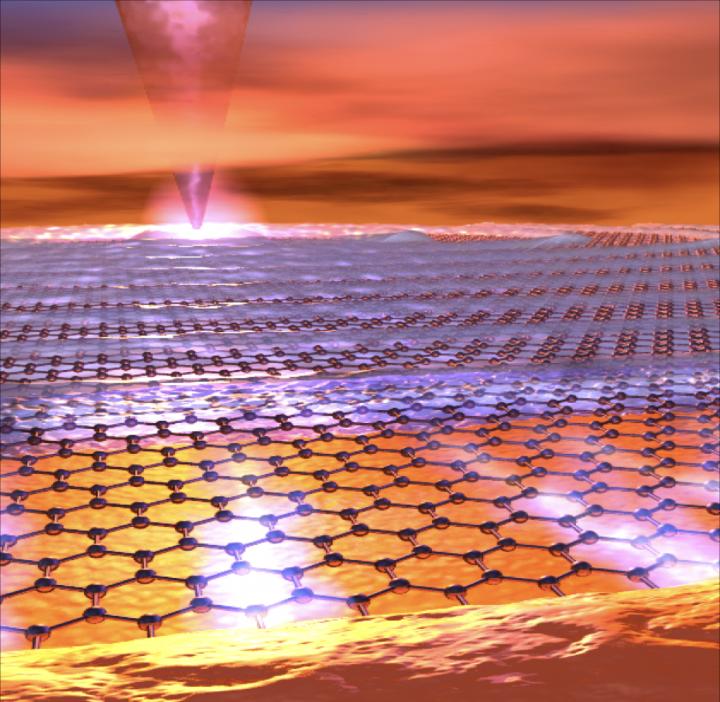

Electrons and light are moving in concert along the graphene sheet.
Credit: ICFO/ F. Vialla
Researchers have studied how light can be used to “see” the quantum nature of an electronic material. They managed to do that by capturing light in a net of carbon atoms and slowing down light it down so that it moves almost as slow as the electrons in the graphene.
Then something special happens: electrons and light start to move in concert, unveiling their quantum nature at such large scale that it could observed with a special type of microscope.
The experiments were performed with ultra-high quality graphene. To excite and image the ultra-slow ripples of light in the graphene (also called plasmons), the researchers used a special antenna for light that scans over the surface at a distance of a few nanometers.
With this near field nanoscope they saw that the light ripples on the graphene moved more than 300 times slower than light, and dramatically different from what is expected from classical physics laws.
The work has been published in Science by ICFO researchers Dr. Mark Lundeberg, Dr. Achim Woessner, led by ICREA Prof. at ICFO Frank Koppens, in collaboration with Prof. Hillenbrand from Nanogune, Prof. Polini from IIT and Prof. Hone from Columbia University.
In reference to the accomplished experiments, Prof. Koppens comments: “Usually it is very difficult to probe the quantum world, and to do so it requires ultra-low temperatures; here we could just “see” it with light and even at room temperature”.
This technique paves now the way for exploring many new types quantum materials, including superconductors where electricity can flow without energy consumption, or topological materials that allow for quantum information processing with topological qubits. In addition, Prof. Hillenbrand states that “this could just be the beginning of a new era of near field nanoscopy”.
Prof. Polini adds that “This discovery may eventually lead to understanding in a truly microscopic fashion complex quantum phenomena that occur when matter is subject to ultra-low temperatures and very high magnetic fields, like the fractional quantum Hall effect”
###
This research has been partially supported by the European Research Council, the European Graphene Flagship, the Government of Catalonia, Fundació Cellex and the Severo Ochoa Excellence program of the Government of Spain.
Reference to the paper:
This paper will be published online by the journal Science on THURSDAY, 8 June 2017 after 2:00pm US EST with the title:
“Tunning quantum non-local effects in graphene plasmonics” and link: http://science.
Link to Graphene at ICFO: http://graphene.
Link to the research led by ICREA Prof. at ICFO Frank Koppens: https:/
ABOUT ICFO:
ICFO – The Institute of Photonic Sciences, member of The Barcelona Institute of Science and Technology, is a research center located in a specially designed, 14.000 m2-building situated in the Mediterranean Technology Park in the metropolitan area of Barcelona. It currently hosts 400 people, including research group leaders, post-doctoral researchers, PhD students, research engineers, and staff. ICFOnians are organized in 27 research groups working in 60 state-of-the-art research laboratories, equipped with the latest experimental facilities and supported by a range of cutting-edge facilities for nanofabrication, characterization, imaging and engineering.
The Severo Ochoa distinction awarded by the Ministry of Science and Innovation, as well as 14 ICREA Professorships, 25 European Research Council grants and 6 Fundació Cellex Barcelona Nest Fellowships, demonstrate the centre's dedication to research excellence, as does the institute's consistent appearance in top worldwide positions in international rankings. From an industrial standpoint, ICFO participates actively in the European Technological Platform Photonics21 and is also very proactive in fostering entrepreneurial activities and spin-off creation. The center participates in incubator activities and seeks to attract venture capital investment. ICFO hosts an active Corporate Liaison Program that aims at creating collaborations and links between industry and ICFO researchers. To date, ICFO has created 5 successful start-up companies.














